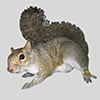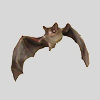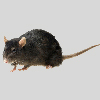Montgomery Wildlife Control
Whether you have a squirrels in your attic, a raccoon problem, a bird or bat issue, snakes, a rat or mouse infestation, skunks, moles and more, we can help.
APX Wildlife
We are a professional wildlife control company servicing the Montgomery, Alabama area. Our line if work is also referred to as nuisance wildlife removal, animal damage control, animal trapping, etc. We specialize in solving conflicts between people and wild animals, throughout Montgomery. Call APX Wildlife any time for a phone consultation to learn about their services, at 334-306-0416.

Though some wildlife removal companies also provide general pest control, including insect control, Alabama animal removal is a specialty service, quite a bit different than the work of a normal exterminator company. Nuisance animal control companies provide
general animal trapping and wildlife prevention, including animal damage repairs. Services may vary, but most companies remove animals in the house or attic like squirrels or rats, and also handle raccoons, opossums, or skunks, bird or bat colony removal, emergency snake or dead animal removal services.
FAQ's
Learn more about APX Wildlife of Montgomery, Alabama.
Services
For an accurate list of services, consult apxalabama.com. Most animal removal companies provide a complete range of services to solve every wild animal problem in Alabama. Not just animal trapping and relocation, but wildlife prevention, such as home repairs to close entry holes, fencing around sheds or decks, etc. Dead animal removal and odor control. Emergency services, such as snake removal. Most companies do rodent control of rats & mice, bat colony removal, bird control and prevention, mole trapping, and even attic cleanup. Call 334-306-0416 to check.
Range
Servicing the Montgomery, Alabama area, but may extend beyond that. If unsure, visit apxalabama.com or call them at 334-306-0416 to find out their service locations and range.
Hours
Most companies do a pretty good job of answering their phone and being available most days, in particular because animals can be trapped on Sundays, or emergencies can happen those days. But hours may vary. Just call 334-306-0416 to see if they're available.
Reviews
You can read reviews of APX Wildlife in Montgomery, AL on sources such as Google My Business listings, Yelp, or even Facebook if they have accounts in these places. You might also find APX Wildlife reviews on Home Advisor, Indeed, BBB, Glassdoor, Nextdoor, Angie's List, or more. I don't know the Better Business Bureau rating of APX Wildlife, or have links to their Facebook page or Yelp, but it's an easy search away. Of course, online reviews, both good or bad, are often fake for various reasons. Your best bet is to call and find out if you like them! Be sure to talk to a technician, not just a phone receptionist.
Prices
Prices for wildlife control are rarely standardized, because every job is different: the type of animal, number of animals, repairs needed, etc. Call 334-306-0416 for better details.
Contact
The best method of contact is to call 334-306-0416, but if you want to email APX Wildlife, visit their website at apxalabama.com and use the published contact form or email.
Jobs
Is APX Wildlife hiring and can you get a job as a critter removal specialist? I don't know - call them and find out.
Animals We Remove
Raccoons cause a variety of problems: they break into attics, damage homes, they steal garbage or pet food, tear up sod, and much more.

Raccoons
Strong & SneakySquirrels commonly enter attics or eaves of homes in the late summer and late winter, where mother squirrels have a nest of young.

Squirrels
Attic InvadersBats love to live in certain buildings, where they can, over time, form huge colonies and leave a lot of guano and urine behind.

Bats
Building ColonizersMost snakes are non-venomous. But many people are unable to correctly identify snake species, and are scared to have these reptiles around.

Snakes
Are they dangerous?Rats and mice commonly enter people's homes, where they can chew electrical wires or wood, eat food, and leave droppings and urine behind.

Rats / Mice
Spread DiseaseOpossums and other ground-dwelling animals such as skunks or groundhogs can dig your yard, rummage pet food or crops, etc.

Opossums
Rummagers / DiggersAbout Alabama Wildlife
Alabama is home, either permanently or temporarily, to a very rich and diverse mix of wildlife, on the land and sea, and in the air. There are almost 400 different species of mussels and freshwater snails, over 450 different species of game and nongame fish, close to 100 species of crayfish, and even sometimes freshwater jellyfish - and those are just a few in the bodies of water in the state.
Alabama Amphibians
70 different species of amphibians inhabit Alabama, including more than 40 species of salamander and 30 frog species. Some of these are quite common in their natural habitats, such as the American toad, spotted salamander, Fowler's toad, two-toed amphiuma, southern toad, southern two-lined salamander, and squirrel tree frog.
You may encounter a few of the rarer species, including the pine barrens tree frog, southern dusky salamander, little grass frog, Tennessee cave salamander, gopher frog, or the official state amphibian: Red Hills salamander (among others).
Alabama Bats
You will find 16 species of bat in Alabama, but two are classed as threatened or endangered in the state, so there's very little chance of a sighting. These are the northern long-eared bat (also known as the northern myotis), and the Indiana bat.
The bat species that you are likely to encounter in the state are: the little brown bat, big brown bat, Brazilian free-tailed bat, evening bat, and the eastern pipistrelle bat (also known as tri-colored bat). These are nuisance animals across most of the state, and the removal of them from residential and/or business properties often requires a licensed professional by law. Several bats are listed on federal and state-level threatened or endangered lists, which means that certain removal techniques are illegal and harmful.
Less common than these are: hoary bat, silver-haired bat, eastern small-footed bat, gray bat, southeastern bat, Rafinesque's big-eared bat, Seminole bat, northern yellow bat, and the eastern red bat. The gray bat is federally listed as an endangered animal and it is believed that almost the entire remaining population inhabits just 11 different caves across North America.
Alabama Birds
Alabama is "home" to quite the vast array of bird species, with more than 150 different species that regularly winter and/or breed in the state. More than 80 other species migrate through Alabama, too. Birds you may spot in the state range from finches, blackbirds and meadowlarks to moorhens, cranes, kingfishers, sparrows, eagles, kestrels, hawks, grebes, hummingbirds, woodpeckers, and many, many more.
All in all, over 400 different birds have been linked to the state, including a few extirpated species, a couple of sadly extinct species, and even four species that are non-native.
Some of the most common birds in Alabama include: wild turkey, wood duck, turkey vulture, Savannah sparrow, sandhill crane, red-headed and red-bellied woodpeckers, various species of warbler, chimney swift, American crow, barred owl, and American robin.
Alabama Carnivores
The bobcat is a relatively common carnivore species in the state of Alabama. Once upon a time, this was joined by cougars, but the latter is sadly now extirpated from the state and is suffering in others.
Once upon a time, you would have also spotted the red wolf in Alabama, but these are thought to have become extirpated at some point during the 1980s. You will still find the coyote there - now the largest Alabama carnivorous animal.
Another Alabama dog/canidae family member is the gray fox - a common pest animal often found in gardens. The red fox is more common, especially in the northernmost regions. This animal is a very adaptable one and can switch up its habits and diet to suit the environment.
You might've been lucky to have seen an American black bear wandering around in the forests of Alabama just a few years ago, but they now only reside in small areas, mostly in the north and north-east of the state. If you live, work or travel to the outer edges, where Alabama meets Florida and Georgia, you might encounter a black bear that has wandered over state lines.
Raccoons and opossums are prolific carnivores and pests across Alabama, and also across much of North America; and you may come across 3 members of the Mustelidae family: the American mink, long-tailed weasel (rare), and North American river otter.
The striped skunk can also be added to the Alabama carnivore list, and, more rarely seen, the eastern spotted skunk.
Alabama Eulipotyphlans
Eulipotyphlans is the family name for animals such as shrews, hedgehogs, mole - all of which can be problematic nuisance animals in back gardens, farms, and businesses. Alabama is home to 6 of these, but the most common is the eastern mole. Less frequently sighted are 4 shrew species: southeastern shrew, North American least shrew, southern short-tailed shrew, and northern short-tailed shrew; and even rarer is the American pygmy shrew.
Alabama Rabbits
The two most common rabbit species found in Alabama are the eastern cottontail and swamp rabbit. These are joined by two rarer species: the marsh rabbit and the Appalachian cottontail.
Alabama Reptiles
This state is home to more than 90 different reptile species, ranging from the American alligator (threatened, according to US Fish and Wildlife) to the 60 different species of snake, 12 species of lizards, and 30-plus species of turtle.
Some of the most popular lizards in the state include the green anole, which is a common back-yard pest in some areas, eastern fence lizard, mole skink, five-lined skink, and little brown skink. Less common sightings can include the eastern six-lined racerunner, southeastern five-lined skink, coal skink, and eastern glass lizard. The mimic glass lizard is thought to have been extirpated from the state now, and a few lizards have been introduced (non-native) to the area: Texas horned lizard, brown anole, Mediterranean house gecko, and Indo-Pacific gecko.
In terms of snakes, only 11 of the 60-plus species found in the state are venomous, and those venomous species are somewhat rare. These include the western pygmy, dusky pygmy and Carolina pigmy rattlesnake (also known as ground rattlesnakes), and eastern coral snake (very rare).
More common venomous species include southern and northern copperheads; Florida, eastern and western cottonmouths, and eastern diamond-back rattlesnakes.
Some of the most common non-venomous snakes you will encounter in Alabama are worm snakes (eastern and midwestern), black racers (northern and southern), ringneck snakes (northern, Mississippi, and southern), rat snakes, mud snakes, king snakes, and hog-nosed snakes - but there are plenty more to enjoy ... from a distance, of course.
Alabama Rodents
In the south-easterly coastal regions of the state, you may find a species of mammal that doesn't actually belong in Alabama: the Coypu, also known as beaver rat, nutria, nutria rat or swamp beaver. The semi-aquatic, large rodent is non-native and thought to have been first introduced to the state in the later part of the 1940s.
You will find a total of 22 species of rodent in Alabama, including 9 species of mouse: the meadow jumping mouse, cotton deer mouse, white-footed deer mouse, oldfield deer mouse, Alabama beach mouse, eastern harvest mouse, golden mouse, Perdido Key beach mouse, and house mouse. The house mouse is a non-native species like the Coypu.
There are also 3 species of squirrel: the gray squirrel, fox squirrel, and southern flying squirrel; and 6 species of rat: Norway rat, black rat, eastern wood rat (rarely), Allegheny woodrat (very rarely), marsh rice rat, and hispid cotton rat. The Norway rat and black rat are, just like the house mouse, non-native.
You can add the woodchuck (or groundhog) to the list of Alabama rodents, as well as the eastern chipmunk, North American beaver, southeastern pocket gopher (rare), marsh oryzomys, prairie vole, woodland or pine vole, and common muskrat.
Alabama Ungulates
Ungulates is the family name for animals such as bison, boar, deer and elk. Elk and American bison/buffalo were once seen in the state of Alabama, but these are believed to be extirpated completely, leaving just 3 others: the non-native fallow deer, white-tailed or Virginia deer, and non-native wild boar. The latter can prove to be quite the formidable pest opponent across the entire state, wreaking utter havoc to native animal populations, trees and plant life, farms, back gardens, and more. It has been estimated that these pest animals, also known as hogs or feral hogs, can cause destruction that amounts to somewhere in the region of 70 to 80 MILLION dollars every single year to the agriculture industry alone.

This is a free listing from Augie of AAA Animal Advertising. It is here because you are either a client of mine, or I'm hoping you will consider hiring me, if your area is available.
A page like this helps your business - it helps more customers find you, your website apxalabama.com and your phone number 334-306-0416. This web page is a valuable citation that links back to your web site and helps your search engine rankings.
I sell wildlife control leads - through my network of dozens of popular nuisance wildlife websites, I generate hundreds of calls per month in the Montgomery area. My leads are of higher quality
and lower cost than other providers, such as Google Adwords, Home Advisor, Yelp, Angie's List, and others. I typically charge a range of $15 - $20 per customer call you receive. I don't do contracts, you only pay after you get the calls,
you can quit any time. Most of my clients have been with me for 5+ years. I have over 200 clients nationwide, and my clients include Terminix, Critter Control, TruTech, as well as many one-man operations.
If you're interested, email me at augiewildlife@gmail.com or call me at 747-777-6115, and we'll discuss if your area is available. Many areas are sold out, but I work every day to generate more leads, and
there's a good chance leads are available for you in Montgomery.